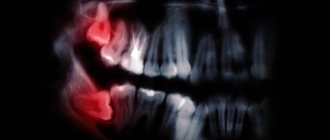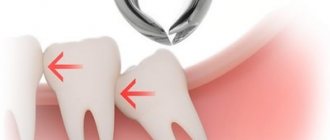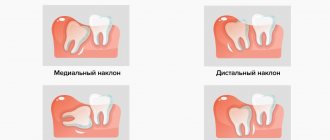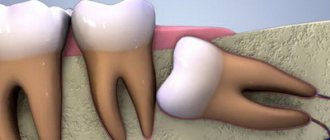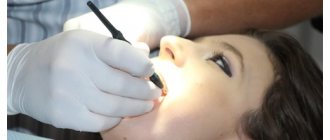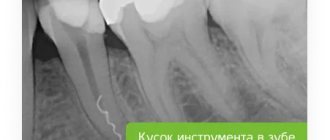Braces are a common method of correcting malocclusion and are suitable for children and adults. Before installing an orthodontic structure, the patient has many questions, one of which is whether it is necessary to remove wisdom teeth before braces. We will talk about this in the article.
In this article
- What are wisdom teeth?
- Why are braces needed?
- Is it necessary to remove figure eights before installing braces?
- Why remove wisdom teeth?
- What is separation?
- Conclusion
What are wisdom teeth?
The third molars, located eighth in the dentition, are popularly called “wisdom teeth”, or “eights”. Usually they erupt at 15-25 years of age, sometimes later, and often do not erupt at all, which is also a variant of the norm. Modern dentistry is of the opinion that the “eight” is a vestigial organ. It was present in human ancestors in its full form, but due to changes in nutrition it gradually lost its functional significance. “Wisdom teeth” received this name because they erupt later than others - during the period of the highest intellectual development of a person and on the eve of the “wise” age.
Dentists often recommend removing figure eights for several reasons:
- When a tooth erupts, it gives the patient unbearable pain, which can be accompanied by an inflammatory process and an increase in temperature.
- Eights are more often affected by caries than others. They grow incorrectly, and food debris accumulates in the area of the junction with the neighboring tooth, and contact caries develops.
- Due to the small size of the upper jaw, third molars grow at an angle and can cause injury to the cheeks. In this case, there is also no doubt whether the eights need to be deleted.
- Against the background of eruption of the third molar, a purulent disease - pericoronitis - can develop. If measures are not taken in a timely manner, there is a danger of developing more serious diseases.
The patient decides together with the doctor whether to remove or leave wisdom teeth. It all depends on the characteristics of eruption, location in the jaw and other factors.
What prevents the harmonious formation of dentition in children?
- If the baby tooth has not fallen out, but the permanent one is already growing.
- Bad habits (finger sucking).
- Adenoids and frequent ARVI “force” the child to breathe incorrectly, which affects the development of the jaw.
- Incorrect posture.
If these problems are resolved in time, treatment in adulthood will be comfortable, and may not be necessary at all.
Recently, doctors are increasingly recommending the removal of “eights”. Wisdom teeth cause more problems for patients than they benefit. They do not take the most active part in the chewing process.
Why are braces needed?
Braces are an orthodontic structure that consists of a metal arch and small plates with locks. The orthodontist attaches braces to the teeth and connects them together with metal wire with shape memory. Trying to take the correct position, the wire pulls on the braces and thus corrects the position of the teeth in the jaw.
Mostly, braces are placed on patients with malocclusion over 14 years of age. Today, bite correction is performed even on adults. If eights have already erupted, the question often arises: is it worth removing wisdom teeth before installing braces? The answer will be individual for each patient, and the doctor will be able to give it only after a preliminary examination.
When should they be removed?
There is no universal answer: in all cases the decision is made individually. Each option has its own arguments for and against, but in general the approach is as follows:
- It is undesirable to remove healthy teeth without compelling evidence.
- Preserving wisdom teeth may carry risks for the remaining teeth and for the course of treatment. Then the benefits of removal outweigh the possible negative consequences.
Should I delete the eights?
The decision is always made individually. Sometimes it happens that one orthodontist prescribes the removal of teeth (not necessarily eights, fangs are also recommended to be removed quite often), and another cancels this decision. There is nothing unusual in this, because each specialist has his own approach and his own vision of treatment planning. Therefore, anyone who doubts the correctness of treatment tactics is recommended to undergo additional consultation with another specialist or consider treatment with a different orthodontic system. This is normal practice as systems improve and more cases of irregularities are corrected without removing teeth.
Other articles:
10 problems of those with malocclusion
All types of orthodontic systems: from plates to aligners
Is it necessary to remove figure eights before installing braces?
Since braces are installed for a long period of time, a thorough examination of the oral cavity is carried out before this and, if necessary, any existing problems are treated. In some cases, it may be necessary to remove teeth before braces:
- For large carious cavities that cannot be filled.
- In the presence of cysts.
- For osteomyelitis and chronic periodontitis
- Teeth with damaged roots.
- Severely loose teeth.
Healthy teeth are removed when there is crowding, and the choice most often falls on the “fours” - the first premolars. They have short roots and removal is easy. In addition, the first premolars are least involved in chewing.
In rare cases, “sevens” are removed - only if the function of the chewing tooth and support for the brace can be taken over by a healthy wisdom tooth. It is also rare that fangs and incisors are removed - only in cases of severe destruction of the root and dental crown or significant deformation. Which teeth need to be removed largely depends on the individual characteristics of the bite. As for the eights, it makes sense to pull out teeth if they grow at an angle and cause severe pain when erupting. Removing figure eights for braces is not necessary if the wisdom teeth are not causing problems, do not affect neighboring teeth, and grow relatively evenly.
Before deciding to remove teeth, the doctor conducts a thorough diagnosis and takes panoramic photographs of the jaw. If braces are placed on a teenager whose wisdom teeth have not yet erupted, in most cases the dentist will not remove them. The rudiments of eights are located under the bone layer in a teenager, and serious surgical manipulation will have to be performed to remove them. After it there may be severe tissue swelling, pain, and difficulty opening the mouth. Until the eights have erupted, it is difficult to predict whether they will be problematic or not. Therefore, the orthodontist most often will not remove unerupted wisdom teeth for a teenager before installing braces.
The exception is cases when the x-ray shows that the third molars are located horizontally in the jaw and can lead to the destruction of the “sevens”. For such indications, the doctor may recommend the removal of unerupted wisdom teeth, even if installation of braces is not planned.
How to prepare teeth for braces?
The first consultation is the most important step on the path to an attractive smile. It includes several procedures that allow the doctor to gain a complete understanding of the patient's problems:
- external examination (face, posture, oral cavity);
- study of the condition of teeth, dentition, jaw bones, soft tissues;
- diagnostics, including obtaining an orthopantomogram, teleroentgenogram;
- studying X-ray diagnostic data and comparing them with visual inspection data.
At this stage, the attending physician decides what treatment measures will have to be carried out before installing the bracket system so that the correction is as effective as possible and occurs without complications. In dentistry they are usually divided into three groups:
- group A includes procedures that ensure the proper quality of treatment - for example, plastic surgery of the frenulum of the tongue and lips, if it was not performed at the stage of primary occlusion;
- group B - preserving oral health;
- in group C - those that minimize the risk of complications.
Activities in Groups B to C include identifying and treating hidden cavities and infected root canals, having your teeth professionally cleaned before braces, and finally deciding whether third molars need to be removed.
Why remove wisdom teeth?
There is a myth that you need to remove wisdom teeth in any case, because they move other teeth in the row and interfere with the correction of the bite when wearing braces. Dentists say that in most cases this is not the case and the size of eights is too small to lead to a shift in the dentition. Therefore, removal of these teeth is not always necessary.
Another common concern among patients is that 8 teeth can break the braces. Doctors reassure: if the braces are installed correctly, the figure eights will not damage them.
Will the treatment time frame change?
Many patients are afraid to undergo tooth extraction because they think it may delay the removal of braces. But this is far from true. If there is severe crowding, removing some teeth will only speed up the treatment process, as it will provide room for the rest to move. The gaps that remain after the operation heal quite quickly. It is recommended to remove problem teeth approximately 7 days before installing braces - so that there is time for the rehabilitation of injured tissues.
Important! To maintain aesthetics, in some cases it may be proposed to install temporary dentures that will hide the resulting gaps.
What is separation?
An alternative to removing figure eights before installing braces is the separation procedure. This method is considered more gentle and physiological for the patient. Its essence is that a thin layer of enamel is removed from the side surface of one or more teeth. This allows you to free up space in your jaw without having to remove teeth. During separation, the dentist removes approximately an enamel layer only 0.25 mm thick, which does not affect the health of the tooth, but can lead to increased sensitivity.
Separation is a relatively simple and painless procedure. Sometimes only 0.2-0.5 mm is missing to turn the tooth, and in this case, removing the enamel layer helps solve the problem. If, for such indications, the tooth is completely removed, more space will be freed up than necessary.
The advantages of separation are obvious:
- after the procedure there is no hole left that needs to be properly cared for;
- there is no risk of complications, infection of the wound, pain, as after tooth extraction;
- The procedure is performed quickly, does not require preparation, and does not cause discomfort to the patient.
Separation is carried out in different ways. The first option is to use thin abrasive strips, or strips. First, the dentist grinds the teeth with them, and then grinds the surface until smooth. Another method is separation using special wedges, which are installed between the teeth for 24 hours and free up the space necessary for the orthodontist.
Since the procedure increases the sensitivity of the enamel, the doctor will recommend remedies to reduce it.
When is it necessary to remove teeth before braces?
Sometimes there really is no alternative to deletion. Moreover, it is not the third molars that have to be removed, but completely different teeth.
Sometimes patients come for a consultation with an orthodontist with straight teeth, but a so-called “convex profile” that prevents them from even closing their lips. In such cases, the removal of “fours” and/or “fives”, first and second premolars helps to correct the situation with both appearance and bite. Removal is performed in pairs - according to indications, in one or both jaws.
Consultation with orthodontist O.A. Baranova
The problem of lack of space for normal teeth growth is quite common. Modern food is processed, soft, and the jaws lack the load necessary for growth and development during the deciduous and mixed dentition period. Underdevelopment of the jaws leads to a lack of space for permanent teeth, which are much larger in size than baby teeth.
Orthodontist O.A. Baranova conducted an examination and talked about the possibilities of orthodontic treatment. There are two treatment options for crowded teeth – with or without tooth extraction. In Olga Baranova's ORTHODONT PROJECT, tooth extraction is rarely used, but in this case, with severe crowding of teeth and a thin biotype of periodontal tissue, the girl still has full-fledged “eights”, so all the signs are for treatment with extraction. In this case, treatment with tooth extraction will lead to the most competent, aesthetic and stable result.
Contrary to a rather strong misconception that everything can always be treated with the Damon brace system without removal, this work shows that NOT AT ALL. And Dr. Dwight Damon himself never proclaimed such a thing. Everything must be done according to indications. In this work O.A. Baranova suggested using Damon braces with tooth extraction. Damon self-ligating braces glide easily along the archwire, applying constant, low forces to your teeth and moving your teeth into new positions faster than other braces. In this situation, a passive self-ligation mechanism was used to quickly close the gaps from the extracted teeth.
For accurate calculations and choice of treatment method, the patient must undergo in-depth diagnostics, which includes photometry, calculation of OPTG and TRG images in the lateral projection, calculation of jaw models, consultations with an osteopath and psychologist.
Photometry before orthodontic treatment:
Orthopantomogram (panoramic image) before treatment:
Treatment plan approval
Based on the results of research and consultations, orthodontist O.A. Baranova drew up a treatment plan, which she introduced to the patient at the second consultation. Calculations of the images showed that the option of removing teeth will prevent problems with the gums and bone tissue of the jaws, fraught with the tooth root extending beyond the cortical plate, and will allow the teeth to be straightened fairly quickly.
Orthodontist diagnosis:
crowding of the frontal group of teeth of the upper and lower jaw, narrowing and shortening of the upper and lower dentition. Occlusion is normal.
The tooth extraction was carried out by a dental surgeon at the clinic, since all the necessary specialists work together with orthodontists.


